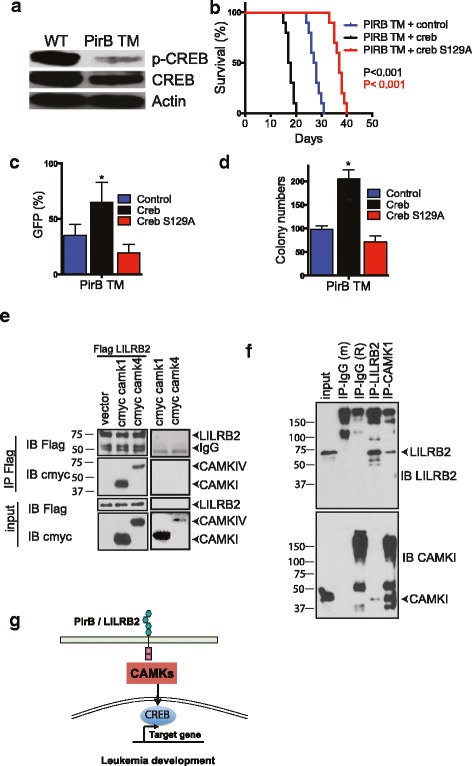Fig. 6.

CREB activity plays important role in PirB/LILRB2-CAMKs signaling in AML-SCs. a Phosphorylation of CREB was decreased in the PirBTM MLL-AF9 AML BM cells compared to control cells. b–d Retrovirally expressed Creb, but not Creb mutant (S129A), rescued PirBTM phenotype upon secondary transplantation. Retrovirally expressed Creb had similar levels as endogenous proteins in WT controls. b Survival curves of mice transplanted with 3000 of these ectopically Creb-expressing, Creb S129A-expressing, or control cells (n = 10 mice). c Percentages of retrovirus-infected (GFP+) AML cells in PB of secondary recipient mice after 28 days of transplantation. (n = 5 mice). d CFU numbers of retrovirus-infected (GFP+) AML cells in colony-forming assays. The experiment was repeated three times with similar results; e CAMKI and LILRB2 bound in transfected 293T cells. The indicated flag-tagged LILRB2 or myc-tagged CAMKI or CAMKIV proteins were overexpressed in 293 cells. Flag antibody was used to precipitate LILRB2 proteins, and the flag or myc antibodies were used in Western blots. f Endogenous CAMKI and LILRB2 interact with each other as determined by bidirectional pull-down assays. MV4-11 cells (1 × 107 cells) were lysed with transmembrane protein extraction reagent and indicated antibodies were used for immunoprecipitation and Western blot; *p < 0.05. g Schematic summary of the signaling pathway mediated by the PirB/LILRB2-CAMKs-CREB in AML cells
